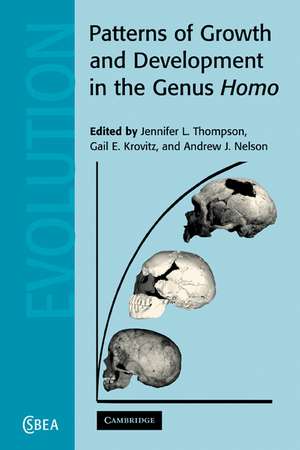Patterns of Growth and Development in the Genus Homo: Cambridge Studies in Biological and Evolutionary Anthropology, cartea 37
Editat de J. L. Thompson, G. E. Krovitz, A. J. Nelsonen Limba Engleză Paperback – 22 dec 2010
| Toate formatele și edițiile | Preț | Express |
|---|---|---|
| Paperback (1) | 426.66 lei 43-57 zile | |
| Cambridge University Press – 22 dec 2010 | 426.66 lei 43-57 zile | |
| Hardback (1) | 1033.84 lei 43-57 zile | |
| Cambridge University Press – 3 dec 2003 | 1033.84 lei 43-57 zile |
Din seria Cambridge Studies in Biological and Evolutionary Anthropology
-
 Preț: 479.80 lei
Preț: 479.80 lei -
 Preț: 390.85 lei
Preț: 390.85 lei - 14%
 Preț: 750.86 lei
Preț: 750.86 lei - 11%
 Preț: 700.59 lei
Preț: 700.59 lei - 14%
 Preț: 722.61 lei
Preț: 722.61 lei - 9%
 Preț: 846.81 lei
Preț: 846.81 lei - 11%
 Preț: 460.98 lei
Preț: 460.98 lei - 11%
 Preț: 566.50 lei
Preț: 566.50 lei -
 Preț: 367.91 lei
Preț: 367.91 lei - 11%
 Preț: 693.77 lei
Preț: 693.77 lei -
 Preț: 356.37 lei
Preț: 356.37 lei - 11%
 Preț: 633.61 lei
Preț: 633.61 lei - 11%
 Preț: 619.90 lei
Preț: 619.90 lei -
 Preț: 396.29 lei
Preț: 396.29 lei -
 Preț: 279.00 lei
Preț: 279.00 lei -
 Preț: 304.74 lei
Preț: 304.74 lei -
 Preț: 371.32 lei
Preț: 371.32 lei -
 Preț: 376.06 lei
Preț: 376.06 lei -
 Preț: 332.66 lei
Preț: 332.66 lei -
 Preț: 421.01 lei
Preț: 421.01 lei -
 Preț: 303.60 lei
Preț: 303.60 lei -
 Preț: 309.27 lei
Preț: 309.27 lei -
 Preț: 376.62 lei
Preț: 376.62 lei - 11%
 Preț: 424.92 lei
Preț: 424.92 lei -
 Preț: 308.50 lei
Preț: 308.50 lei -
 Preț: 317.11 lei
Preț: 317.11 lei -
 Preț: 453.33 lei
Preț: 453.33 lei -
 Preț: 322.41 lei
Preț: 322.41 lei -
 Preț: 433.83 lei
Preț: 433.83 lei -
 Preț: 435.78 lei
Preț: 435.78 lei -
 Preț: 471.93 lei
Preț: 471.93 lei - 11%
 Preț: 474.71 lei
Preț: 474.71 lei -
 Preț: 428.90 lei
Preț: 428.90 lei - 14%
 Preț: 934.70 lei
Preț: 934.70 lei
Preț: 426.66 lei
Nou
Puncte Express: 640
Preț estimativ în valută:
81.67€ • 88.74$ • 68.64£
81.67€ • 88.74$ • 68.64£
Carte tipărită la comandă
Livrare economică 21 aprilie-05 mai
Preluare comenzi: 021 569.72.76
Specificații
ISBN-13: 9780521184229
ISBN-10: 0521184223
Pagini: 470
Dimensiuni: 152 x 229 x 24 mm
Greutate: 0.62 kg
Editura: Cambridge University Press
Colecția Cambridge University Press
Seria Cambridge Studies in Biological and Evolutionary Anthropology
Locul publicării:Cambridge, United Kingdom
ISBN-10: 0521184223
Pagini: 470
Dimensiuni: 152 x 229 x 24 mm
Greutate: 0.62 kg
Editura: Cambridge University Press
Colecția Cambridge University Press
Seria Cambridge Studies in Biological and Evolutionary Anthropology
Locul publicării:Cambridge, United Kingdom
Cuprins
List of contributors; Acknowledgements; 1. Introduction G. E. Krovitz, A. J. Nelson and J. L. Thompson; Part I. Setting the Stage: What Do we Know about Human Growth and Development?: 2. The human pattern of growth and development in paleontological perspective B. Bogin; 3. Postnatal ontogeny of facial position in Homo sapiens and Pan troglodytes B. McBratney-Owen and D. E. Lieberman; 4. Variation in modern human dental development H. Liversidge; 5. Developmental variation in the facial skeleton on anatomically modern Homo sapiens U. Strand Vidarsdóttir and P. O'Higgins; 6. Linear growth variation in the archaeological record L. T. Humphrey; 7. Hominid growth and development: the modern context J. L. Thompson, A. J. Nelson and G. E. Krovitz; Part II. The First Steps: From Australopithecines to Middle Pleistocene Homo: 8. Reconstructing australopithecine growth and development: what do we think we know? K. L. Kuykendall; 9. Growth and life history in Homo erectus S. C. Antón and S. R. Leigh; 10. Patterns of dental development in Lower and Middle Pleistocene hominins from Atapuerca (Spain) J. M. Bermúdez de Castro, F. Ramírez Rozzi, M. Martinón-Torres, S. Sarimiento Pérez and A. Rosas; 11. Hominid growth and development from australopithecines to Middle Pleistocene Homo G. E. Krovitz, J. L. Thompson and A. J. Nelson; Part III. The Last Steps: The Approach to Modern Humans: 12. Diagnosing heterochronic perturbations in the craniofacial evolution of Homo (Neandertals and modern humans) and Pan (P. troglodytes and P. paniscus) F. L. Williams, L. R. Godfrey and M. R. Sutherland; 13. Shape and growth differences between Neandertals and modern humans: grounds for a species-level distinction? G. E. Krovitz; 14. Ontogenetic patterning and phylogenetic significance of mental foramen number and position in the evolution of Upper Pleistocene Homo sapiens H. Coqueugniot and N. Minugh-Purvis; 15. A new approach to the quantitative analysis of postcranial growth in Neandertals and modern humans: evidence from the hipbone T. Majó and A.-M. Tillier; 16. Ontogenetic variation in the Dederiych Neandertal infants: postcranial evidence O. Kondo and H. Ishida; 17. Hominid growth and development in Upper Pleistocene Homo A. J. Nelson, G. E. Krovitz and J. L. Thompson; 18. Conclusions: putting it all together A. J. Nelson, J. L. Thompson and G. E. Krovitz; Index.
Recenzii
Review of the hardback: 'This volume shows how far research in this area has come in the last few decades … This book is an excellent addition to the literature on growth and development, and a long overdue examination of our own genus's growth and development.' Osteoarchaeology
Review of the hardback: 'This book is an excellent addition to the literature on growth and development, and a long overdue examination of our own genus's growth and development.' International Journal of Osteoarchaeology
Review of the hardback: 'This book is an excellent addition to the literature on growth and development, and a long overdue examination of our own genus's growth and development.' International Journal of Osteoarchaeology
Descriere
This book focuses on species within the genus Homo to investigate the evolutionary origins of characteristic human patterns.









